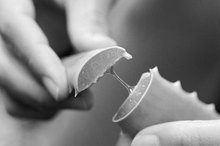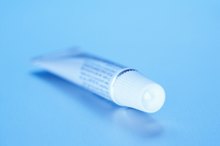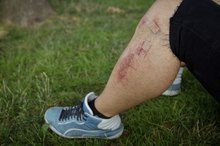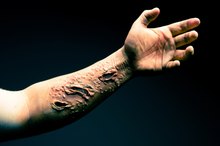Side Effects of Topical Aloe Vera
Aloe vera is generally accepted as an unsurpassed healing plant; it was presented to dead pharaohs as a burial gift, and known in Egypt as the “plant of immortality.” Also known as burn plant, lily of the desert or elephant’s gall, aloe is easy to grow indoors, making it an instant home remedy for minor burns or skin irritations. All you have to do is break or cut open a leaf and apply the thick gel inside to the affected area.
Benefits
Aloe encourages quick healing with little or no scarring, may reduce pain and inflammation from skin injuries, and is sometimes used topically to reduce already formed scars or stretch marks. Aloe may also be useful as a before-sun treatment to help reduce the effects of the sun’s ultraviolet rays, and is a common ingredient in cosmetic products and moisturizers because its topical application stimulates elastin and collagen synthesis.
Uses
Natural Alternatives to Polysporine
Learn More
Aloe vera is used topically to treat sunburns and minor burns, plus a wide variety of skin conditions like shingles, eczema, ultra-violet induced erythema and other inflammatory skin conditions, psoriasis, acne, genital herpes, cold sores and scrapes. Its apparent anti-inflammatory and analgaesic properties also lend it to use on arthritic joints. While most scientific proof indicates that aloe encourages the faster healing of skin injuries, it should never be applied to open wounds.
Medications
Topical aloe may enhance hydrocortisone’s ability to reduce swelling and inflammation. While there are a few cautions about aloe-medication interactions with oral aloe use, there are no other cautions about topical aloe use.
Regulation
Is the Aloe Vera Plant Toxic?
Learn More
As an herbal supplement, aloe vera is not subject to regulation by the U.S. Food and Drug Administration regarding safety, efficacy or purity. This means that even though topical aloe’s reported side effects are both minor and rare, you should still be wary of products advertised as aloe supplements that in fact have very little aloe in them, may be mixed with other products that do produce unwanted side effects, or may be contaminated through substandard production or quality control practices.
Minor Irritation
While aloe vera is typically accepted as a proven topical healing herb, and no serious side effects have been reported with its use, on rare occasions there have been reports of skin burning, redness or rash.
Yellow
If you are using raw aloe gel from the inside of an aloe leaf, be aware that the aloe latex, a sticky yellow liquid just inside the outer surface of the aloe leaf, may stain your skin yellow if mistakenly applied. This stain will wash away easily with water, but may be embarrassing, especially if you have applied it to your face to soothe a sunburn.
Related Articles
References
- Sacred Earth
- National Center for Complementary and Alternative Medicine
- Dat, A.; Poon, F.; Pham, K. et al. Aloe vera for treating acute and chronic wounds. Cochrane Database Syst Rev. 2012 Feb 15;(2):CD008762. DOI: 10.1002/14651858.CD008762.pub2.
- Haddad, P.; Amouzgar-Hashemi, F.; Samsami, S. et al. Aloe Vera for Prevention of Radiation-Induced Dermatitis: a Self-Controlled Clinical Trial. Curr Oncol. 2013 Aug;20(4):e345-8. DOI: 10.3747/co.20.1356.
- Heggie, S.; Bryant, G.; Tripcony, L. et al. A Phase III Study on the Efficacy of Topical Aloe Vera Gel on Irradiated Breast Tissue. Cancer Nurs. 2002;25(6):442-51.
- Langmead, L.; Feakins, R.; Goldthorpe, S.et al. Randomized, Double-blind, Placebo-controlled Trial of Oral Aloe Vera Gel for Active Ulcerative Colitis. Aliment Pharmacol Ther. 2004;19(7):739-47. DOI: 10.1111/j.1365-2036.2004.01902.x.
- Paulsen, E.; Korsholm, L.; and Brandrup, F. Double-blind, Placebo-Controlled Study of a Commercial Aloe Vera Gel in the Treatment of Slight to Moderate Psoriasis Vulgaris. J Eur Acad Dermatol Venereol. 2005:19(3):326-31. DOI: 10.1111/j.1468-3083.2004.01186.x.
- Suksomboon, N.; Poolsup, N.; Punthanitisarn, S. et al. Effect of Aloe vera on glycaemic control in prediabetes and type 2 diabetes: a systematic review and meta‐analysis. J Clin Pharm Ther. 2016;41(2):180-8. DOI: 10.1111/jcpt.12382
- Zhang, Y.; Liu, W.; Liu, D. et al. Efficacy of Aloe Vera Supplementation on Prediabetes and Early Non-Treated Diabetic Patients: A Systematic Review and Meta-Analysis of Randomized Controlled Trials. Nutrients. 2016 Jul; 8(7): 388. DOI: 10.3390/nu8070388.
Writer Bio
Lisa Maloney is a travel and outdoors writer based in Anchorage, Alaska. She's written four outdoors and travel guidebooks, including the award-winning "Moon Alaska," and regularly contributes to local and national publications. She also has a background in personal training, with more than 6,000 hours of hands-on experience.









